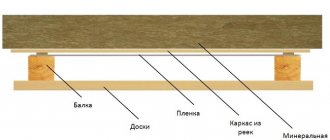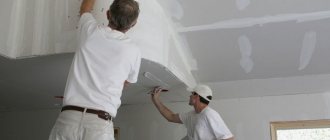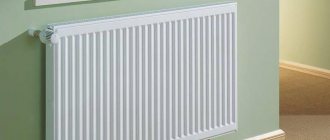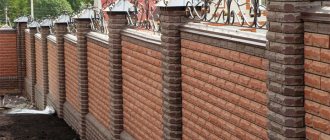What is a distribution (junction) box
This is an electrical product, which is a closed housing made of metal or dielectric material.
The second option is preferable, provided that the material is sufficiently reliable from a fire safety point of view. That is, it must be non-flammable, or at least not support combustion. Inside, power cables and supply wires are connected for consumers or switching devices. The junction box must provide protection for internal connections from dust, moisture, and foreign objects. In addition, the product prevents accidental contact with exposed areas of the electrical circuit (current-carrying busbars, contacts).
The shape of the box, as well as its dimensions, are not regulated - the format of the product is selected based on the installation conditions. However, manufacturers adhere to certain standards for compatibility with various fittings and components.
Detailed connection diagram
During operation of the electrical wiring, malfunctions may occur - for example, a circuit break has occurred. If during electrical installation the workers did without switchboards. boxes, and the joints were simply rolled up with a finishing material such as plaster, then in order to get to the joints again, you will have to disturb the external finish - tear off the wallpaper, break the layer of plaster, etc.
It is unlikely that anyone will be satisfied with such prospects. If in the future you need to install additional sockets, then in such cases it is not always convenient to pull wires from previously installed sockets; it is easier to organize the connection directly to the box.
If the wires are connected using terminal blocks, then you will have to drill a fairly deep channel into the wall, which is much more labor-intensive than a simple connection in a junction box.
Finally, from a fire safety point of view, the advantage of using junction boxes is undeniable. For the correct organization of electrical installation work, there are special Rules for the Construction of Electrical Installations (PUE), which also regulate the procedure for connecting electrical wires.
Main function of distribution box
Using this electrical product, you can significantly reduce the cost of organizing electrical wiring. Without this element, each electrical appliance would have to be connected to a separate cable, which would increase the number of channels required for installation and spoil the appearance.
Proper distribution of the cable inside the box will increase the safety of residential and non-residential rooms. This is due to the insulation of connecting points with flammable materials contained in the wall. The design of the equipment is thought out to the smallest detail, therefore it guarantees ease of repair work.
But the main function of the box is related to the uniform distribution of electrical energy between all consumers installed in the room. In addition, the product structure takes into account potential expansion due to the addition of new branches of the electrical circuit.
Is it possible to do without junction boxes at all?
Theoretically, yes. But to do this, you will need to connect the distribution panel and each place of electricity consumption in the apartment with a separate wire. This will lead to high consumption of electrical wiring and the need to make wide and deep grooves. to be able to lay several rows of wire in them.
Ultimately, the disadvantages of this method will many times outweigh the disadvantages of using junction boxes. Savings due to abandoning the latter will be many times depreciated by increased costs for electrical wiring.
One can sometimes hear this as an argument against the use of junction boxes; Although laying a separate line to each point of consumption is economically inferior to the option with junction boxes, it is safer, since it eliminates the connection of wires at nodal points.
There is only one answer to this. Correct, professionally performed connection of wires in a junction box is absolutely safe. While everyone has the right to their own point of view, the option of using junction boxes is still more preferable than without them.
Types of connections
Types of wire connections
What is the task when connecting wires? Ensure good contact between the cores so that the chain does not break and there is no risk of a short circuit. In order to ensure this, you can act in several ways:
- Twisting.
- Crimping.
- Welding.
- Soldering with a soldering iron.
- Use of screw terminals.
- Bolted connections.
- Self-clamping terminals.
These are time-tested methods that you can use to ensure reliable contact. Let's take a closer look at each of them. You will learn how to properly connect wires using any of these options.
Types of distribution boxes
Based on the body material, boxes are divided into:
- Metal - for installation in rooms built from flammable materials (wood, plastic), or on walls insulated with flammable material. They may have a dielectric layer inside to reduce the likelihood of unauthorized contact closure.
- Plastic are the most common due to their low manufacturing cost. They are made either from non-flammable material, for use in conditions of high fire danger, or from materials that do not support combustion. That is, the junction box in any design should not become a source of fire, even if the wiring ignites inside.
According to installation conditions:
- For indoor installation. Designed for installation in walls and cladding. They consist of a body, which must be firmly held in the supporting structure, and a flat cover. In turn, the cover must be removable for access to the contact group or twists. In such boxes, the thickness of the case can be thinner, because it does not bear the structural load.
As a rule, built-in boxes are made in a round shape. When installing into a monolithic wall, drilling an installation hole using a crown is much easier. For installation in drywall, you can use rectangular (square) housings. It is easy to cut such a hole in the gypsum board. From the point of view of connecting wires, it is more convenient to work with a square (rectangular) case. - For outdoor installation (non-sealed) - conditions of use - indoors or closed cabinets. The housing is both protection from the external environment and a strength element of the structure. Therefore, it must be thicker and stronger.
To prevent foreign objects from getting inside, the outer boxes are equipped with sealing clamps for wires. - For outdoor installation (sealed). Installation of the distribution box outdoors involves direct exposure to water, frost, and fog. Since water is a conductor, the inside of the housing must be dry. Therefore, sealed boxes have a rubber seal along the sealing contour of the lid, and crimp (collet) clamps for inserting wires.
- Of course, additional equipment of products (moisture protection, etc.) increases the cost. Therefore, when choosing a package, we usually proceed from the principle of reasonable sufficiency.
Junction boxes can be equipped with a ready-made set of connectors for wires. Or you buy an empty case, and the fittings are selected separately.
Kinds
Boxes for connecting electrical wires come in different types and are classified according to many parameters.
By installation method
First of all, they are divided depending on the installation method:
- A distribution box for open electrical wiring (otherwise known as “outdoor installation”) is mounted on wall surfaces. To install it, no preliminary preparation of the base is required. It is attached directly to the wall surface using various fasteners.
- The distribution box for hidden wiring (it is called “internal installation”) is mounted in a special recess in the wall, which is drilled during installation work. These junction boxes, in turn, differ depending on the material of the wall in which they will be mounted. If it is in a concrete or brick wall, then you need to use a special crown to make a recess to fit the dimensions of the box. Simply cut a corresponding hole in drywall or other sheet materials.
By material
Boxes vary depending on the material from which they are made. First of all, these must be materials that would provide the connected wires with maximum protection for the entire service life. In this regard, electrical wiring boxes are made of high quality plastic and metals, which are also coated with a protective layer of anti-corrosion paint or primer.
For the manufacture of metal boxes, tinned steel sheets or aluminum alloys, which are not subject to corrosion, are used. If a fire occurs, the metal case will serve as protection for the contents of the box for some time, during which time it will at least be possible to de-energize the electrical network. Metal boxes are most often used in general purpose buildings (garages, utility rooms, sheds).
A plastic junction box will protect electrical connections no less effectively. For their manufacture, polyamide, polypropylene or cast fluoroplastic are used; these materials are not subject to decomposition by active substances. These plastic boxes provide excellent insulation against electric shock. In addition to good insulating properties, they also have sufficient mechanical strength. A plastic junction box is resistant to aggressive chemical liquids and can be kept in a humid environment much longer than a metal one. If there is a danger of open fire, then plastic does not burn, but melts; in this, of course, it is inferior to metal.
By other parameters
Distribution boxes vary in size and the following criteria play a major role here:
- their purpose;
- number of inputs;
- protection class.
At a minimum, the box can have two inputs, that is, two wires will be connected in it. The maximum number of inputs in one distribution box is 16. Accordingly, the more inputs, the larger the box in size and depth.
Boxes vary in shape and can be round, square or rectangular. For outdoor installation, it makes no difference at all what shape you use the box. But for indoor installation it is better to take a round one, because if you have a concrete wall, then making a hole in it is much easier than drilling a square niche.
All of the above criteria add up to the price of the junction box. The price is also affected by the degree of protection of this element:
- IP 20, IP 30 – for use only in dry rooms, there is no protection from humidity;
- IP 44 - for use outdoors and in rooms with high levels of humidity; when installing outdoors, you must choose a place under a canopy or canopy, and also avoid direct exposure to dust and water jets;
- IP 55 - for use in places exposed to precipitation, that is, boxes with this degree of protection can be installed outdoors in any conditions, they are completely protected from dust and water jets;
- IP 67 – for use outdoors in any weather conditions, as well as on the ground and in the ground;
- IP 68 - boxes with this degree of protection can be used immersed in water; as a rule, the immersion depth is additionally indicated for each product on the packaging or case.
For household electrical networks, boxes with a degree of protection of IP 55 are most often used.
What is the difference between metal products
Cable connection points for lighting wiring, as well as power lines designed for voltages not exceeding 1000 W, are often organized inside metal junction boxes.
Metal junction box: 1 – cover fastening hole; 2 – inner wall of the housing (aluminum); 3 – hole for DIN rail fastening; 4 – outer wall of the housing with epoxy coating; 5 – clamp for “ground”; 6 – cover seal.
The metal configuration is a kind of universal option for such products. These boxes can be used not only for AC or DC networks, but also for networks:
- telephone;
- television;
- computer;
- informational.
Metal boxes are manufactured based on alloys that are chemical and corrosion resistant. The outer surface is coated with a special epoxy resin, which provides additional mechanical strength and ultraviolet protection. The housing may have from 2 to 6 inputs with threaded fittings.
When closed, the entry of foreign matter into the metal box is prevented due to the high-quality sealing of the lid and cable entries. Installation of boxes of this configuration is permissible indoors and outdoors. They are usually installed in combination with rigid metal pipes that act as cable ducts. Product protection class IP66 – IP67.
DIY installation instructions
When purchasing products for installation, you should keep in mind: each branded product is usually packaged and accompanied by a product label.
Each branded product must be accompanied by a label with the technical parameters and other information indicated on it. This way you can distinguish the original product from a fake. The product label indicates: technical information, product barcode, certification mark.
Dimensions and installation location
A standard box for household needs is 10 centimeters in diameter.
Design features and dimensions depend on the number of inputs and the number of consumers. The greater the electrical demand, the larger the distributor.
Overhead devices are usually mounted 15–30 cm below the ceiling. This is a special maneuver by electricians to minimize access and eliminate an accident. If the apartment has a suspended ceiling, the box is skillfully disguised as a rubberized sheet. This is an erroneous action during installation, since access to the point should always be unobstructed.
In order to hide the wiring, distribution. the box is installed in a specially drilled hole in the wall of the specified diameter. The height of the point is determined similarly to overhead boxes.
Installation of various types of fittings
Outdoor installation:
- On the body of the junction box, cut off the plugs of the sealed inputs with a sharp thin knife. The cuts are made along the marking lines on the plug in accordance with the diameter of the cable channel or the cable itself.
- Tubular channels - corrugated or straight plastic tubes - are inserted into the holes formed after the cuts.
- The ends of the wires are led into the junction box body through the channels.
If necessary, install a terminal block in special guides and connect the conductors according to the diagram. To finish, close the junction box with a lid, pressing it with some force until it is completely secured with locks.
Instructions in pictures for installing an external electrical junction box. The standard option, which is used in most cases of installation of household electrical wiring
Instructions for installing an external universal box for cable duct:
- Make cuts using a knife according to the standard marks on the box body to the size of the rectangular cable channel. Standard tags are designed for joining with cable channels with a cross-section of at least 10*7 mm, maximum 40*25 mm.
- Carefully break off the notched part of the plastic housing, thus obtaining an opening for the cable channel.
- Attach terminal blocks to the base of the universal box for mechanical connection of electrical conductors.
Having laid the electrical wiring through the cable channel, connect the ends of the conductors according to the diagram on the terminals. When the work is completed, install the box cover and secure it with a fastening screw.
Instructions in pictures for installing a junction box in combination with a rectangular plastic cable duct. This is also an outdoor mounting option
Installation procedure for the installation (hidden) box:
- Prepare the product by first preparing the required number of input holes in the housing. Holes are created by breaking the edges of the finished stencil. Up to 11 stencils for inlet holes can be placed on the body of the installation box.
- Make a mounting hole in a hollow wall, for example, in plasterboard, using a cutting bit to match the diameter of the product. Or use a ready-made mounting hole in a solid wall.
All that remains is to connect the cable channels with the wire, combine them with the box, bring the ends of the wiring under the connections and fix the box body by spreading the fastening legs with screws (for drywall) or fill it with solution.
Installation is carried out approximately in this way according to the instructions for installing distribution (installation) boxes of hidden wiring. This option is often used for installing electrical wiring in urban apartments.
Having connected the conductors of the hidden main in accordance with the wiring diagram, close the box(es) with a lid. Externally, this design fits well into the existing interior.
- We insert the cables into the junction box and cut them so that the length of each remnant is 3-5 cm greater than the diameter of the box body
- We remove the general insulation from each of the cables placed in the box. You need to remove approximately 8-11 cm
- We remove 11 mm of insulation from the wires being prepared for connection. We check whether the current-carrying conductor was damaged when removing the insulation
- We separate the wires stripped before connection in different directions. Lightly clean the current-carrying wires with sandpaper and straighten them with pliers
- We first place the terminals on the wires of the input cable. Then we make connections sequentially in accordance with the insulation color
- We fix the wires held by each terminal with plastic clamps so that they can be conveniently placed in the box.
- We place the created nodes in the box body, trying to evenly distribute all the wires in it without overlaps or intersections
- After checking whether one of the wires has come loose during installation, close the box with the front panel by snapping it onto the body
- Step 1: Entering cables into the junction box
- Step 2: Stripping Cables with a Stripper
- Step 3: Stripping the insulation of the connected wires
- Step 4: Route the wires in different directions
- Step 5: Installing terminals on the input wires
- Step 6: Fixing the connected wires with clamps
- Step 7: Laying Assemblies in the Junction Box
- Step 8: Attaching the Bezel
Installation of a metal junction box
The design of metal junction boxes provides only for external installation of such products.
Therefore, the instructions in this case are simple:
- Bring tubular channels with wire to the entry points.
- Mechanically thread the pipes to the walls of the housing and lead the cable ends into its internal area.
The box body is secured to the wall with screws through the holes intended for fastening. Then connect the cables according to the diagram, cover the box and secure the cover with screws.
This is what the installation of electrical wiring looks like with the inclusion of a metal junction box. The set of tools for installing different types of boxes is the same. This is roughly how the installation of distribution modules with different designs is carried out.
Connection creation mechanism
Wiring your home is not difficult. To do this you need to have the necessary knowledge and equipment. The equipment is purchased in the store; you don’t even need to buy knowledge. At the very beginning, a diagram of the electrical network should be drawn up. In most cases, the owner of the construction hires an electrician who does not imagine the future location of the furniture and, as a result, switches are covered by doors, sockets in the corners are covered by furniture.
- As a rule, electricians draw diagrams with chalk on the wall of the future equipment, but it is better to place a diagram of the electrical network with the placement of electrical current collectors on the floor plan as a separate drawing, including the switching (connection) of the power cable cores in the distribution box - this will help:
- calculate the load on the electrical network;
- wire cross-section;
- divide consumers into groups.
- In terms of a household electrical circuit, there are at least two groups of electrical consumers:
- lighting;
- power part, that is, sockets.
It is best that these two circuits are mounted with separate power cables. If you plan to install powerful electrical appliances: electric stove, oven, boiler - these devices must have their own separate circuit, i.e. separate switch, fuse and cables.
Connection of wires in the junction box according to the PUE
PUE is a collection of regulatory documentation for the design and installation of electrical circuits; in fact, it is a desktop Bible for all people who begin to engage in electrical work. The collection shows the basic principles of creating circuits, the rules for their calculation, protection and communication devices. Further, all descriptions of electrical devices will be in accordance with the rules according to the PUE.
Selecting the cross-section and brand of wire
To lay electrical wiring in rooms and connect wires in a junction box, according to the PUE, the conductors must have a different color insulating coating, from the same manufacturer with the same color scheme. For wiring, it is best to use VVGNG brand wire - single-core copper, flat, double insulated, best with the additional designation NG, which means non-flammable.
It is best to purchase a cable from a well-known manufacturer, which must have a certificate. There is no need to take a wire without markings; electrical wiring in the house is, first of all, safety and is done for more than one year, so saving is inappropriate here. It must be taken into account that a copper cable with the same cross-section can withstand one and a half times more load than aluminum.
Attention! For a capital circuit, you cannot use a multi-core PVS or ShVVP cable. Although these wires are soft and more convenient to lay, they have a higher current resistance, and accordingly they will heat up more when a load is connected.
Power calculation
One of the basic rules for calculating the cable cross-section: used in the calculation of 1 sq. mm - 9 A. electric current, that is, a cable with a cross-section of 1 mm can withstand the load of a kettle or iron with a power of 2 kW.
- Based on these recommendations, at least the following should be used for wiring in the house:
- lighting core is 1.5mm square, which corresponds to 10 - 12A;
- sockets in rooms are 16A, which corresponds to a cross-section of 2.5 mm. sq.
- kitchen electric ovens, the wire for which must withstand 25A. - this is a 4mm section. kv;
- The core of a four-burner electric stove must withstand 32A. - cross section 6 mm2.
Correct choice of electrical connection. wires in the junction box depends on its cross-section. Attention! You cannot use electrical cables from different manufacturers, as they have different specific (ohmic) resistance per 1 linear meter.
Electrical junction box and wire connection
After laying the wires, according to the drawn up diagram, they must be connected to each other. In order for the connection to be in one place, there are communication boxes (distribution boxes). Depending on the installation, device connections can be round or square, deep or shallow, and are divided into internal (for hidden wiring) and external according to the method of fastening.
According to the requirements of the PUE, the electrical cable must extend at least 15 cm from the ceiling, taking into account all canopies. At the same distance, a device for switching cable cores is also attached. To install the internal box, a niche corresponding to the outer diameter of the sleeve is drilled in the wall; for external mounting, it is made directly to the wall.
How many wires can you twist in a junction box? You should not skimp on junction boxes and try to put as many wires there as possible - it will be inconvenient to connect, and all of them may not fit. As a rule, 3-4 wires are inserted into one junction box.
Requirements for installation of distribution boxes
Let's look at the requirements for the installation of distribution boxes, as well as the location of their installation.
- The installation height of the device is 10-30 cm from the base surface of the ceiling. The exact size is determined by the height of the ceilings themselves.
- If hidden wiring is used inside the building, then a niche is made for each box to suit its size and shape. In this case, the installation depth should be such that the device cover is ultimately flush with the finished wall surface.
- If an overhead model is used, then it is installed directly on the already prepared decorated wall.
- A very important point, which is indicated in the PUE, is a free approach to the installation site of the distribution box for maintenance and repair.
- An equally important point, or rather, the most important, is knowledge of where the distribution box of a hidden installation is located.
- Don't forget about the aesthetic side of things. Therefore, the lid of the box is sealed to match the overall design of the room or a device with a decorative lid is selected.
- If the installation location of the plastic distribution device is under a suspended or suspended ceiling structure, it is necessary to leave a hatch in the latter for free access to the device cover.
Where and how to install distribution boxes
Usually the boxes are located under the ceiling at a distance of 100-200 mm from it. The specific value depends on the height of the room. If the wiring is hidden, then the product is placed inside the wall to a certain depth so that the surface of the cover is flush with the wall. For open-type electrical wiring, external boxes are suitable.
In accordance with the rules for the construction of electrical installations (PUE), it is important to provide free access to the junction box cover, which is necessary in case of inspection or troubleshooting. If the product is external and attached directly to the wall, then this condition is met automatically.
When placing the device in a wall recess, two requirements must be met. Firstly, you need to know where it is installed, and secondly, you should ensure timely access to the product without compromising its aesthetics. If the latter can be neglected without violating the PUE, then the first requirement is mandatory and important.
You can maintain an aesthetic appearance by gluing beautiful wallpaper, and then carefully trim around the lid of the junction box without removing the part that is glued to it. When choosing alternative finishes, make sure that the color of the surface of the lid and the wall are identical. Try to make sure that if you need to remove the cover, the wall in this place does not collapse. If suspended ceilings are installed, then small hatches should be created to provide access to the boxes.
Layout
To begin, make a flowchart that makes it clear which consumer groups need to be created. Then the power on each branch is calculated.
There are two methods of load distribution:
- Interior. An introductory (basic) box is organized in each room. Power lines are laid from the base points to the input distribution board. Each line is started on a separate machine. In the case where powerful electrical equipment (boiler, air conditioner, electric stove) is installed in some rooms, a separate line of power sockets is laid. Then the basic distribution box is disconnected for each consumer in the room. For this purpose, additional junction boxes can be installed. An approximate diagram of the basic boxes looks like this:
- By consumer groups. Separate lines are laid for the lighting of all rooms, for the low-load socket network (TV, computer, table lamps), and for the power socket network. These wires are also connected to the circuit breakers of the input panel. Again, distribution boxes are installed along each line at the tapping points to individual consumers.
Next comes the dirty work: actually installing the boxes and laying the cable lines.
Hidden installation
Wiring is laid between the nodal points (where the boxes are installed). Since the installation is hidden, the walls are grooved for the cable, and the boxes are installed on alabaster. The prepared wires are removed from the installed boxes for connection. The length of the free ends should provide the possibility of connection without interference, and allow for 2-3 alterations (with cutting off the used conductors).
The method of connection does not matter (soldered twist in the illustration), the main thing is to understand the principle itself. For cables, the flush-mounted boxes have marked holes. In this case, tightness is not required; there will be a wall and plaster around it. The secret is that alabaster, diluted to a creamy consistency, when installing the box, fills all the cracks, grooves and extra holes.
The result is a monolith with dielectric walls. The planting depth is calculated taking into account the thickness of the wallpaper and the shape of the lid.
Outdoor installation
This type of installation is simpler and does not take much time. Here are step-by-step instructions that will help you install the junction box in the wall yourself:
- Turn off the power in the house and check for power using an indicator screwdriver. We talked about how to use an indicator screwdriver in the corresponding article.
- Mark the attachment points with a simple pencil.
- Secure the box to the concrete wall using dowels. The design of the product includes 2 holes for self-tapping screws.
- Cut off the ends of the seals to enter all groups of wires. The cuts should have a diameter slightly smaller than the cable cross-section to protect the wiring from dust and moisture.
- Connect the wires together. To do this, we recommend that you familiarize yourself with the color coding of the wires. All you need is to correctly connect phase to phase, zero to zero and ground to ground (for the socket group). To connect the input group to the group of switches and lighting, read the article: how to properly connect a light switch.
- Insulate joints with PVC insulation if necessary.
- Close the lid.
That's the whole technology for installing a distribution box in concrete with your own hands. I would also like to immediately note that the most reliable way to connect wires is soldering and vago terminals.
Various ways to connect switches and lighting fixtures
- Classic connection using a junction box.
The neutral and phase wires are inserted into the box. For simplicity, we will leave protective grounding out of brackets. The neutral wire is directly connected to the lamp. The phase is supplied to the switch, then transits through the box and connects to the second input of the lamp. From an installation point of view, 3 two-core wires enter the junction box. Using the same principle, two or three-key switches are connected. Only more transit phase wires (from keys to lamps) will pass through the box. If you connect several lamps to one switch, there is no point in installing several distribution boxes. You can connect lamps in parallel, starting from the first lamp. In this case, the switch will be a group switch. - Wiring for a lamp without junction boxes.
In this case, a power cable is inserted from the nearest distribution box into the switch housing. The neutral wire is connected to the lamp directly, and the phase wire is opened by a switch. On the one hand, this saves one box. On the other hand, the cable is laid irrationally and must be inserted into the switch housing from below or from the side. While according to the standard generally accepted scheme, the main line runs along the ceiling. And from the ceiling junction boxes, the wiring goes down to the sockets or switches.
How to connect sockets
In most cases, sockets are connected in groups, for which a separate current-carrying line is used. Three cables with two or three conductors go inside the box. Brown usually indicates “phase”, blue - “zero”, yellow-green - “grounding”. There are alternatives to these colors with the following standard - red, blue and black respectively.
The wires need to be grouped by color, folded, pulled and cut to obtain equal lengths. Be sure to do this with a small margin of up to 10 cm to leave room for repeated distribution and switching. Next, perform switching using the selected method. If two wires are connected (without grounding), then the circuit remains the same, only simplified.
Varieties
The main criterion for different types of distribution boxes is the method of their installation, it can be open or closed.
The closed type involves installation in a recess in the wall. Wiring along the walls is covered with plaster and then connected in a box. After all the wires are securely connected and laid, the product is placed in a recess in the wall and then covered with plaster.
After installation, it is invisible to others, this is especially good in cases where the apartment is designed in Provence or Scandinavian style.
Open boxes are placed directly on the wall. They are often used in entrances or offices, as they will not be conspicuous there. The main advantage of open boxes is quick access to wiring.
In conditions of a large number of consumers through one cable, an open box allows for quick diagnosis and repair of wiring.
Open types are also divided into several more subtypes; you need to familiarize yourself with them in order to know which distribution box is best to choose for each individual case. Among them, the most popular are:
Standard. Such boxes are used in industrial premises and public utilities. They do not have additional protection or fixation, so they are the cheapest of the options presented;
With dust protection. Such products provide additional protection against small particles that get inside the box and can shorten the service life of the connection. They are mainly used in wood and stone processing enterprises, as well as in very dusty rooms;
Moisture resistant. Between the moving parts and at the cable connections, they contain special rubber gaskets that protect the wiring from contact with water;
Protected and fortified. In those rooms where increased load may be placed on the equipment, or where the temperature is constantly high, more reliable protective frames are needed;
Distribution boxes with terminal block. Such boxes are pre-provided with special grooves through which several wires can be securely connected. These products allow you to connect the ends directly in the box; you do not need to buy additional terminals or wrap the ends of the wires with electrical tape.
Methods for connecting wires in junction boxes
Putting the wires inside the box is half the battle. Now you need to choose a connection that is reliable and easy to maintain.
All cable line connections are divided into two main categories:
- Detachable, that is, the wiring can be disconnected and reconnected many times, without critical damage to the wire or connecting device. For example, a screw connection on terminal blocks.
- One-piece, that is, when the conductors are separated. the connection is destroyed. There is no big problem with this, it’s just that the cable gets shorter each time, and the connecting devices have to be purchased again.
The type of splicing when disconnecting boxes is selected based on the design of the overall network. If you plan to periodically disconnect one or two branches from a common box, it is better to choose a screw connection or reusable quick-release terminals.
Security measures
The most important thing when installing a distribution box is compliance with basic safety measures. Wires of different metals should be connected only through adapters, and not directly. Plus, do not confuse phase with neutral and ground. And before closing the junction box with decor, if a hidden wiring option is chosen, you should check the entire system for functionality.
Standard color scheme for phase identification











